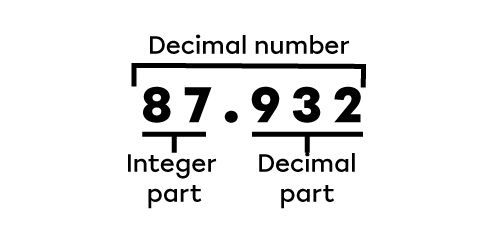A decimal number is made up of an integer (whole) part and a decimal part. A decimal point separates the two parts.

The decimal places include tenths and hundredths. The tenths and the hundredths values are less than one. |1| tenth has a value of | \dfrac{1}{10}| and |1| hundredth has a value of | \dfrac{1}{100}.|

A decimal number is made up of an integer (whole) part and a decimal part. A decimal point separates the two parts.

The decimal places include tenths and hundredths. The tenths and the hundredths values are less than one. |1| tenth has a value of | \dfrac{1}{10}| and |1| hundredth has a value of | \dfrac{1}{100}| .

The basic unit of currency (coins and bills) is the dollar.
Read the following concept sheet to learn more:
Adding decimal numbers is performed the same way as adding whole numbers. The decimal point must be placed in the correct position in the answer.
Read the following concept sheet to learn more:
Subtracting decimal numbers is performed the same way as subtracting whole numbers. The decimal point must be placed in the correct position in the answer.
Read the following concept sheet to learn more:
La monnaie et les billets de banque ont une valeur dont l’unité de base est le dollar.
Pour en savoir plus, tu peux lire la fiche suivante.
L’addition de nombres décimaux se fait de la même façon que l’addition de nombres entiers. La virgule doit être placée au bon endroit dans la réponse.
Pour en savoir plus, tu peux lire la fiche suivante.
La soustraction de nombres décimaux se fait de la même façon que la soustraction de nombres entiers. La virgule doit être placée au bon endroit dans la réponse.
Pour en savoir plus, tu peux lire la fiche suivante.
A decimal number is made up of an integer (whole) part and a decimal part. A decimal point separates the two parts of a decimal number.

The decimal places include tenths, hundredths, and thousandths. The value of the tenths, hundredths, and thousandths is less than one. |1| tenth has a value of |\dfrac{1}{10},| |1| hundredth has a value of |\dfrac{1}{100},| and |1| thousandth has a value of |\dfrac{1}{1\ 000}.|

A decimal number is made up of an integer (whole) part and a decimal part. A decimal point separates the two parts of a decimal number.

The decimal places include tenths, hundredths, and thousandths. The value of the tenths, hundredths, and thousandths is less than one. |1| tenth has a value of | \dfrac{1}{10}| , |1| hundredth has a value of | \dfrac{1}{100}| , and |1| thousandth has a value of | \dfrac{1}{1\ 000}.|

The basic unit of currency (coins and bills) is the dollar.
Read the following concept sheet for more information:
Multiplying decimal numbers is performed the same way as multiplying whole numbers. Count the number of digits after the decimal points in each of the factors to know where to place the decimal point in the answer.
Read the following concept sheet to learn more:
Dividing decimals is performed the same way as dividing whole numbers. The decimal point must be placed in the answer before dividing the decimal part.
Read the following concept sheet for more information:
La monnaie et les billets de banque ont une valeur dont l’unité de base est le dollar.
Pour en savoir plus, tu peux lire la fiche suivante.
La multiplication de nombres décimaux se fait de la même façon que la multiplication de nombres entiers. Tu dois compter le nombre de chiffres qui sont après la virgule dans les facteurs pour savoir où placer la virgule dans la réponse.
Pour en savoir plus, tu peux lire la fiche suivante.
La division de nombres décimaux se fait de la même façon que la division de nombres entiers. La virgule doit être placée dans la réponse avant de diviser la partie décimale.
Pour en savoir plus, tu peux lire la fiche suivante.